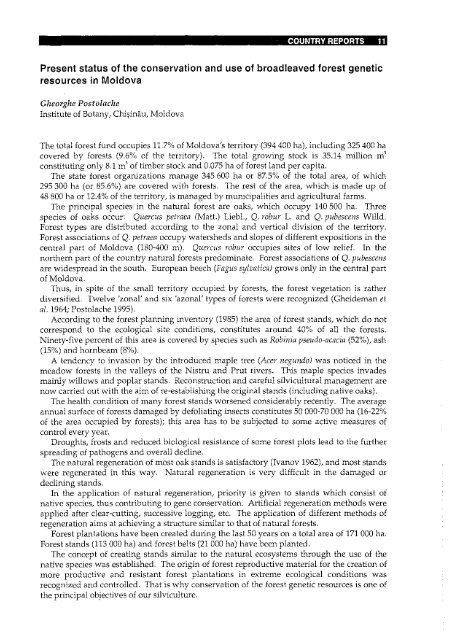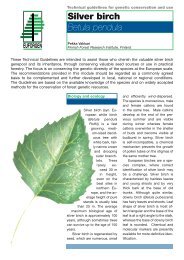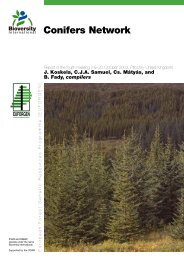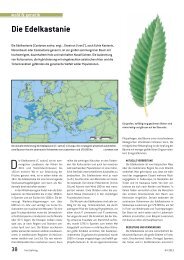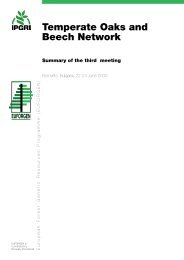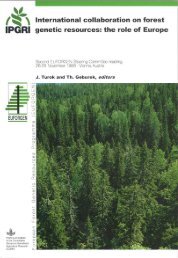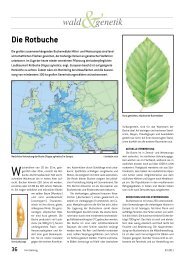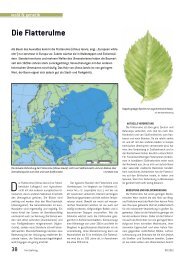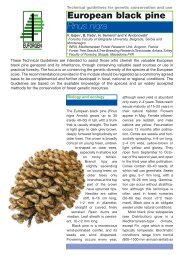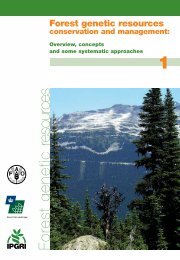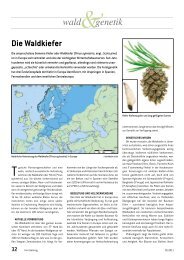Download PDF - Euforgen
Download PDF - Euforgen
Download PDF - Euforgen
Create successful ePaper yourself
Turn your PDF publications into a flip-book with our unique Google optimized e-Paper software.
· GOI.JNmR¥ REBORmS 11<br />
Present status of the conservation and use of broad leaved forest genetic<br />
resources in Moldova<br />
Gheorghe Postolache<br />
Institute of Botany, Chi;>inau, Moldova<br />
The total forest fund occupies 11.7% of Moldova's territory (394400 ha), including 325 400 ha<br />
covered by forests (9.6% of the territory). The total growing stock is 35.14 million m 3<br />
constituting only 8.1 m 3 of timber stock and 0.075 ha of forest land per capita.<br />
The state forest organizations manage 345600 ha or 87.5% of the total area, of which<br />
295300 ha (or 85.6%) are covered with forests. The rest of the area, which is made up of<br />
48800 ha or 12.4% of the territory, is managed by municipalities and agricultural farms.<br />
The principal species in the natural forest are oaks, which occupy 140500 ha. Three<br />
species of oaks occur: Quercus petraea (Matt.) Liebl., Q. robur L. and Q. pubescens Willd.<br />
Forest types are distributed according to the zonal and vertical division of the territory.<br />
Forest associations of Q. petraea occupy watersheds and slopes of different expositions in the<br />
central part of Moldova (180-400 m). Quercus robur occupies sites of low relief. In the<br />
northern part of the country natural forests predominate. Forest associations of Q. pubescens<br />
are widespread in the south. European beech (Fagus sylvatica) grows only in the central part<br />
of Moldova.<br />
Thus, in spite of the small territory occupied by forests, the forest vegetation is rather<br />
diversified. Twelve 'zonal' and six 'azonal' types of forests were recognized (Gheideman et<br />
al. 1964; Postolache 1995).<br />
According to the forest planning inventory (1985) the area of forest stands, which do not<br />
correspond to the ecological site conditions, constitutes around 40% of all the forests.<br />
Ninety-five percent of this area is covered by species such as Robinia pseudo-acacia (52%), ash<br />
(15%) and hornbeam (8%).<br />
A tendency to invasion by the introduced maple tree (Acer negundo) was noticed in the<br />
meadow forests in the valleys of the Nistru and Prut rivers. This maple species invades<br />
mainly willows and poplar stands. Reconstruction and careful silvicultural management are<br />
now carried out with the aim of re-establishing the original stands (including native oaks).<br />
The health condition of many forest stands worsened considerably recently. The average<br />
annual surface of forests damaged by defoliating insects constitutes 50 000-70 000 ha (16-22%<br />
of the area occupied by forests); this area has to be subjected to some active measures of<br />
control every year.<br />
Droughts, frosts and reduced biological resistance of some forest plots lead to the further<br />
spreading of pathogens and overall decline.<br />
The natural regeneration of most oak stands is satisfactory (Ivanov 1962), and most stands<br />
were regenerated in this way. Natural regeneration is very difficult in the damaged or<br />
declining stands.<br />
In the application of natural regeneration, priority is given to stands which consist of<br />
native species, thus contributing to gene conservation. Artificial regeneration methods were<br />
applied after clear-cutting, successive logging, etc. The application of different methods of<br />
regeneration aims at achieving a structure similar to that of natural forests.<br />
Forest plantations have been created during the last 50 years on a total area of 171 000 ha.<br />
Forest stands (113 000 ha) and forest belts (21 000 ha) have been planted.<br />
The concept of creating stands similar to the natural ecosystems through the use of the<br />
native species was established. The origin of forest reproductive material for the creation of<br />
more productive and resistant forest plantations in extreme ecological conditions was<br />
recognized and controlled. That is why conservation of the forest genetic resources is one of<br />
the principal objectives of our silviculture.


